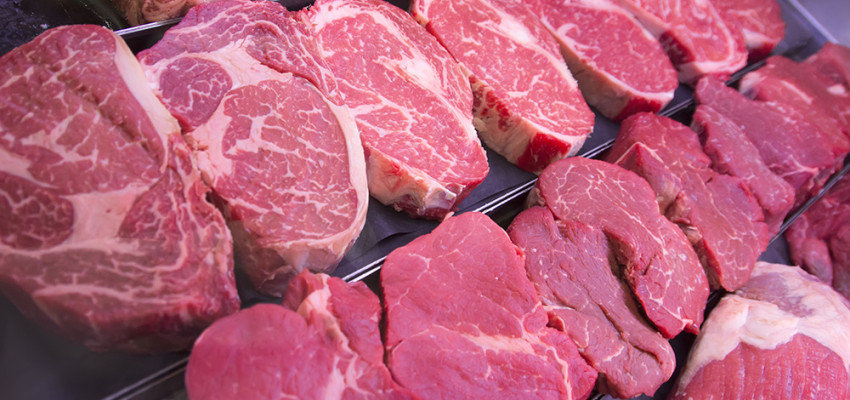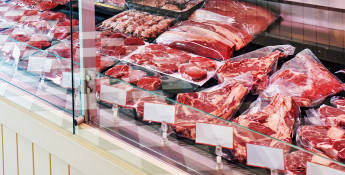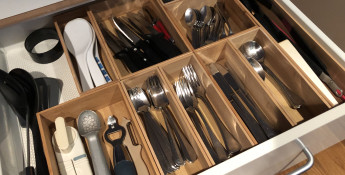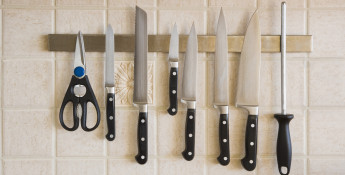By Chef Alli on September 1, 2021
Safely Cooking and Handling Meat

When it comes to safely handling and cooking raw meat and poultry at home, these tips will ensure you keep your family and friends healthy.
Make safe selections at the grocery store
Sidestep any meats or poultry that have damaged packaging. This can be an indicator that it’s possibly been exposed to air and bacteria. For vacuum-packaged meats, don’t purchase any if the seal is broken or the packaging is leaking.
Don’t purchase any meat or poultry that isn’t cold to the touch. Be certain the packaging doesn’t contain excessive liquid. This can mean there has been temperature abuse.
Poultry and meat with a strong odor should also be avoided. Check the expiration date, and never purchase meat or poultry if it’s past the sell-by date.
Check out the meat and poultry case at the end of your shopping trip to decrease the time it is in your cart and out of refrigeration. Before placing meat or poultry into your shopping cart, place them into a plastic bag to prevent meat juices from leaking onto other items. If plastic bags aren’t available in the meat department, you can always use bags from the produce section.
Is your drive home longer than one hour? Be sure to place the meat or poultry into a cooler to keep them chilled and safe.
Immediately refrigerate or freeze
If you are planning to freeze the meats you have purchased at the grocery store, it’s helpful to portion and repackage them into portions you’ll use for upcoming meals. This will make cooking easier in the future.
Remove the meat or poultry from the original packaging and place the desired portions into heavy-duty freezer bags or air-tight containers, removing as much air as possible.
Keep the raw meat and poultry and their juices completely out of reach from other foods. Use hot soapy water to wash and sanitize all utensils, work surfaces and counter-cutting areas that came in contact with the meat and poultry.
Keep raw meat contained
When storing raw meat in refrigeration (whether fresh meat or meat that is being thawed to cook later), it’s important to always take a couple of extra precautions to protect all other foods in the fridge from contamination.
Keep any type of meat, poultry or fish sealed in air-tight containers. If sealed containers are not available, be sure to place packaged meat into large mixing bowls to keep any meat juices contained and other foods safe.
As an extra precaution to prevent cross-contamination, always store meat on the very lowest shelf in the refrigerator to prevent any type of meat juice from dripping down onto other foods.
If raw meats and poultry are not going to be cooked right away, transfer them to the freezer for safe storage. Ground meats can be safely stored in refrigeration for one to two days before cooking. Roasts and steaks can be safely stored in refrigeration for three to four days before cooking.
Use separate cutting boards
Cutting boards are not the place for shortcuts. Yes, we all want to wash fewer dishes, but using the same cutting board for raw meats and fruits/veggies is a way to cross contaminate--something we absolutely DO NOT want to do.
Using the same cutting board for meats and fruits/veggies is a surefire way to get the whole family sick with salmonella poisoning.
The FDA advises us to use two separate cutting boards: one for raw meat, poultry and seafood, and the second one for fresh fruits and veggies.
As a precaution, you may want to have cutting boards that are completely different in appearance from each other to make it easy to distinguish between cutting boards for meats and cutting boards for fruits and veggies.
If you must use the same cutting board, always prepare the fruits and veggies first, then move on to the raw meat, poultry or seafood preparation.
To keep your cutting board safe, sanitary and bacteria free, always scrub it with hot, soapy water that’s had 2-3 tsp. of bleach added, then let it completely air dry.
When oiling a wooden cutting board to keep it in good shape, always be sure to oil it with mineral oil, never any other oil, such as olive oil or vegetable oil.
Thaw it right
Meat or poultry thawed at room temperature is put at great risk. Because the exterior thaws much more quickly than the interior, it can reach unsafe temperatures. While the center remains cold and safe, the exterior may not be. Never thaw meat or poultry on the counter at room temperature.
Because thawing meat and poultry in refrigeration is the slowest method, you may want to employ one of two other safe ways to thaw: by submerging the package of meat or poultry in cold water (a cold-water bath) or thawing it in the microwave on the defrost setting.
Defrosting in refrigeration
Refrigeration thawing assures meat and poultry will remain at a safe, constant temperature of just around 40 degrees F., making it the easiest and safest way to defrost even though it does take longer.
Ground meat, steak, stew meat and chicken breasts (in approximately one-pound quantities) should defrost within 12 to 24 hours. Whole, bigger pieces of bone-in meat or poultry may take two or three days. Large frozen meat items, such as roasts, turkey or ham, require at least 24 hours of defrosting time for each five pounds of meat or poultry.
Keep in mind refrigeration thawing times can vary based on refrigerator cycles and the temperature of the shelf the meat or poultry is resting on, so factor in a bit of extra time just to be on the safe side.
Another great perk of defrosting in refrigeration is that meats and poultry can be refrozen without cooking if they have not been in the fridge for longer than two days.
Defrosting in a cold-water bath
To thaw meat or poultry in cold water, be sure the meat is sealed within leak-proof packaging or tucked into a sealed freezer bag. Bacteria in the surrounding environment can be introduced to the meat via the water, creating an unsafe product.
Completely submerge the frozen meat or poultry in cold water, making sure to change the water every 30 minutes. Small packages of meat or poultry (one pound or so) typically thaw in an hour or less. Larger pieces of meat or a whole chicken will take at least three to four hours.
Meat and poultry thawed using the cold-water bath method should not be refrozen; cook the meat or poultry immediately following the defrosting period.
Defrosting in the microwave
If you choose to thaw meat or poultry in the microwave, plan to cook it immediately after defrosting. Because thawing in the microwave is part of a pre-cooking process, you will need to cook the meat immediately following the microwave defrosting cycle.
Meat or chicken defrosting in the microwave cannot be refrozen unless it is fully cooked.
Cooking from frozen
Because we sometimes fail to plan when life gets hectic (and it always does), you may be wondering if it is safe to cook frozen meat or poultry. You sure can (but see my note below about slow cookers). Just know it will take about 50 percent longer than the time required for cooking thawed meat and poultry.
Don’t rinse before cooking
When you wash (rinse) meat, meat juices are splattered everywhere, including the sink, faucet, nearby counters and whatever happens to be near your sink at the time, such as other foods, utensils, dish towels, etc. Talk about a cross-contamination nightmare. Don’t do it!
Remember, as whole muscle meat (such as steak and chops) cooks, the exterior quickly reaches a safe high-heat temperature that kills any pathogens that lie on the exterior. When cooking chicken breasts, the exterior will also reach the same safe high-heat temperatures, making it safe to eat if the final internal cooking temperature is 160-165 degrees F.
It really is unnecessary to rinse meat or poultry. However, because I know some of you feel absolutely compelled to rinse meat before cooking, be sure to use the lowest water pressure setting, keeping the meat or poultry very deep in the sink to prevent splatter to other areas around the sink.
Make sure to sanitize your sink following the rinse, as well as the surrounding areas.
If you do choose to rinse your meat or poultry, always pat it dry on the exterior before cooking it. This ensures you’ll get nice browning on the exterior when the meat hits the cooking surface.
Don’t cross contaminate
Though bacteria can’t live for more than a few minutes when it comes into direct contact with salt, it can live on the edges of a box, container or shaker.
To avoid contamination of seasonings and rubs, never work directly from the containers in which they are purchased or stored.
Instead, transfer a small amount of the seasoning at a time to a small bowl. This way, you can reach into the bowls for seasonings without having to wash your hands every time you touch raw meat or fish as you are seasoning.
Afterward, toss any seasonings that remain in the bowls, then place the bowls into hot, soapy water or a hot dishwasher cycle.
Stay out of the danger zone
Understanding the danger zone goes a long way toward keeping all foods (and especially meat and poultry) safe to consume.
What is the danger zone? It’s defined by the U.S. Food Safety and Inspection Service (FSIS) as the temperature range in which food-borne bacteria can grow, which is 39-140 degrees F.
The FSIS says potentially hazardous foods should never be stored in this temperature range (39-140 degrees F.) to prevent food-borne illness. Any food that remains in the danger zone for more than two hours must not be consumed.
Besides raw meat and poultry, other foods that are especially susceptible to the danger zone are eggs, dairy products, mayonnaise-based dishes, leftovers, soup and stews.
Here’s a good danger zone question: If 140 degrees F. is the top of the danger zone range, why is it safe to eat a rare steak that has an internal temperature of 125-130 degrees F.? How can this be safe?
Most pathogens are found on the surface of meat. Therefore, as the steak hits the hot grill or skillet, the exterior almost immediately reaches 140 degrees F. or above, destroying most of the pathogens that may be there.
Because the interior of the steak is not penetrated by the exterior pathogens, it can be cooked just to rare or medium-rare internal doneness, as preferred, making them safe to eat for most people. Elderly individuals, pregnant women and anyone with a compromised immune system are advised against eating rare or medium-rare meat.
As for ground meats where surface pathogens could potentially be mixed throughout the entirety of the meat as it is ground, the best practice is to fully cook all ground meat to an internal temperature of 160-165 degrees F.
If you opt to eat that rare, juicy burger that your heart desires, do so at your own risk. To be extra safe, it’s always suggested to order burgers at your local diner with “no pink in the center” instructions.
Another danger zone question that may surprise you: Is it safe to cook frozen meat in a slow cooker?
According to the USDA, always thaw your meat before cooking in a slow cooker. The potential for frozen meat to stay between 40 degrees and 140 degrees F. (yep, the danger zone!) during the cooking process is simply too risky. And spending too much time in the danger zone is what could allow dangerous bacteria (like salmonella) to grow, even though the finished temperature of slow-cooked meat or poultry will be safe and hot.
Temping
For checking the internal temperature of meat or poultry, use an instant-read meat thermometer. Ground beef should be cooked to an internal temperature of 160-165 degrees F.; steaks should be cooked to 130-135 for rare, 135-140 for medium rare, and 145-150 degrees F. for medium.
Using an instant-read meat thermometer when cooking meat and poultry not only ensures the meat is cooked to a safe temperature, but also that it’s not overcooked, producing tough, dry textures.
Remember to refrigerate any meat leftovers within two hours after cooking.





